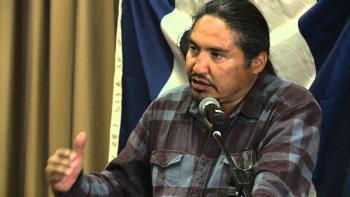Image Caption
Summary
Local Journalism Initiative Reporter
Windspeaker.com
Update with communication from federal Crown-Indigenous Relations Minister Marc Miller.
Frustration and anger blast from Athabasca Chipewyan First Nation Chief Allan Adam as he waits for test results from the drainage pond overflow from Kearl mine that happened upstream from his community.
“The Alberta government has done nothing. Premier (Danielle) Smith says that ‘go ahead and eat the food. Everything you guys eat is all good from wherever you guys take it from.’ She doesn’t have the science behind it,” said Adam.
In a news conference, Smith said that had the incident been communicated in a timely manner by the Imperial Oil-operated mine, “misinformation” about the drinking water being unsafe would not have happened.
The Alberta Energy Regulator (AER), which is overseen by Alberta Energy, knew of the industrial wastewater seeping from the external tailings area both on and outside the boundaries of the Kearl site since May 19, 2022, when it issued an environmental protection order (EPO). The AER was notified by Kearl mine of seepages, including one in close proximity to Waterbody 3, which is fish-bearing, with tributaries that feed the Firebag and Muskeg rivers, which flow into the Athabasca River.
However, it wasn’t until AER issued an EPO this past Feb. 6 in response to at least 5.3 million litres of toxic chemicals that overflowed Feb. 4 from a dam at the Kearl mine into the environment and upstream of Fort Chipewyan, that ACFN was notified.
The wastewater exceeds federal and provincial guidelines for iron, arsenic, sulphates and hydrocarbons that could include kerosene, creosote and diesel.
Adam says that he has spoken with Stephen Guilbeault, federal minister of Environment Climate Change Canada (ECCC), and asked him to look into the incident.
“We put our concerns to him. It’s up to his department now to look at our concerns and look at our request for an independent investigation about what has happened here,” said Adam.
He expects that such an investigation would involve everything from the lack of communication of Imperial Oil and the AER with the ACFN to testing samples from the site.
Adam is not aware of Environment Canada having sampled the site yet. He is also frustrated that ACFN community monitors have not been able to take samples from the site.
In a timeline of events provided to Windspeaker.com from Guilbeault’s office, the department says from Feb. 7, when it was contacted by First Nations about the spill and seepage, to Feb. 14, Environment Canada has “engaged in working level discussions” with AER as the federal ministry prepared for its initial onsite inspection.
On Feb. 14, reads the timeline, ECCC collected samples from the site to be tested and reviewed along with samples collected by Imperial and “in the context of additional relevant information.”
ECCC plans to have discussions with the province and Imperial about “expediting water quality testing and sharing of information with the affected First Nations.”
“ECCC Enforcement is actively involved in this inspection,” said Kaitlin Power, spokesperson for Guilbeault.
In a statement from Guilbeault provided to Windspeaker.com, the minister says he has spoken with ministers Patty Hajdu (Indigenous Services Canada) and Marc Miller (Crown-Indigenous Relations Canada) and says they have “offered assistance to affected communities with provisions, including fresh water.”
Adam says he has had no contact with either Hajdu or Miller. Miller's office reached out to Windspeaker.com to say the minister and his chief of staff had spoken to Adam last week. Spokesperson Renelle Arsenault would not say what they spoke about.
“If the (waste) water is contaminated, would you drink water from the system? If Mr. Guilbeault is going to assist us with clean drinking water, let’s just do it. There’s no question to be asked…industry dropped tailings water into the system,” said Adam.
Mikisew Cree First Nation Chief Billy-Joe Tuccaro has assured his members that before the ice-road melts, safe drinking water will be transported to the community, which is also downstream from the Kearl mine.
In a March 7 community bulletin to members, Tuccaro noted that testing of water undertaken by the Rural Municipality of Wood Buffalo on Jan. 23, indicated the drinking water was safe. However, testing took place prior to the massive Feb. 4 overflow of tailings wastewater.
Tuccaro said Mikisew was “committed to ensuring that our own land users and monitors are out observing the areas near the sites/downstream as the snow/ice melt.”
Imperial is tentatively set to meet with community members the week of March 20, said Tuccaro.
Also expressing concern with the lack of communication and the spill is the Northwest Territories.
“This violates the Bilateral Water Management Agreement with Alberta which commits our governments to communicating quickly and transparently about issues which could affect shared waters. This is not the first time that information hasn’t been shared in a timely manner,” said environment minister Shane Thompson in the NWT legislature.
At this point, he added, there was no evidence for concern for water quality in the NWT.
In a March 6 statement, the AER said it was continuing to oversee Imperial Oil’s containment and clean-up of both the earlier incident and the drainage pond overflow.
“The AER will continue to provide updates to potentially affected communities and is actively monitoring the situation at the Kearl site for Imperial’s ongoing compliance to the order,” reads the statement.
Alberta Environment Minister Sonya Savage said in a March 3 statement that they are “monitoring the situation” at the Kearl site and were “standing by” to assist ACFN and any other impacted communities.
Never miss a Windspeaker article. Subscribe Today to our new Windspeaker Newsletter!
Local Journalism Initiative Reporters are supported by a financial contribution made by the Government of Canada.

